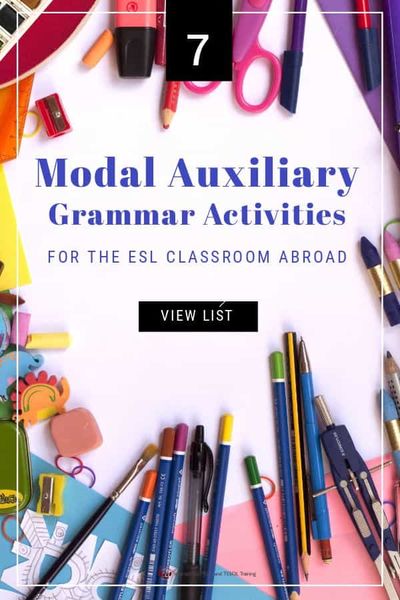7 Activities for Teaching Modal Auxiliary Verbs in the ESL Classroom

The number of combinations of modals and usages is enormous, so TEFL certified teachers often spend a lot of time trying to find an activity that suits their particular teaching point. Here, we give you some adaptable ideas which should save you time thinking or searching, assuming you already have good grammatical knowledge of the subject and a little bit of creativity.
Table of Contents
Are you ready to teach English abroad?
Check out what our course grads say in our many video testimonials!
It's often better to spend a bit of time creating your own material rather than looking fruitlessly on the internet. You will also be able to personalize the content for your students, improve your own skills, and build up a great resource bank. If you need to improve your knowledge of modal auxiliary verbs, look at your ITTT course materials.
Listen to this blog post:
Language Tennis
A standard ESL classroom game that students, young and old, always seem to enjoy. It involves minimal preparation beyond planning the initial prompts. Either write your prompts on slips of paper or put them on the board. Organise students into two teams, and have them line up in two rows. The idea of the game is for you to criss-cross up the line of students getting them to say alternatives until such time as something is repeated, or a student can't think of anything new. At that point, the opposing team gets a point and you start with a new prompt at the person that was last to speak.
Some suitable teaching points might be: can/ability, can/possibility, should/advice, must/obligation. Negatives can be used for any of these too. Language you would expect students to use for the prompt "can/possibility/on a beach" would be: You can sunbathe > You can play volleyball > You can see waves…. If you manage to get up and down the line without any errors, simply end that 'round' and move to the next prompt to keep up the fun variety element.

Mill-drill/Mingling
Another standard ESL classroom activity that generates very natural use of the target language. Create a questionnaire which students use to ask each other questions and to record their answers. This lends itself well to any combination of modal and usage with a little creative thought. For example can, could or may for requests can be turned into a fun activity whereby students must respond to the requests in the negative, giving different polite reasons.
Create your questionnaire so that students can record the names of the people they've spoken to and the reasons given. They choose the best responses to tell the class at the end of the activity. For example: May I borrow your pen? Responses could be as simple as "No, sorry you can't because it's run out of ink" to "No, sorry you can't as you press too hard and might damage it".
Also Read: 11 Fun ESL Activities for Young Learners
Group Discussions or Debates
Whilst this may not be suitable for lower level students, it is a great one for pre-intermediate level and above. Set students up into groups and give them a question to discuss and report back about. It's best not to have groups larger than four students so that you help maximize individual student talk time. You can also encourage quieter students to contribute during the feedback session. This works particularly well for "should/advice".
Give each group the same question from an agony aunt column and allow them a few minutes to come up with some advice. Discuss their suggestions in the feedback session, and then repeat with another problem. This repetition should help students improve the use of the target language each time. Other suitable topics are "can/possibility" (set groups up as travel agents), "must/obligation/prohibition" (strictest company rules) and "will/promises" (create an incentive scheme).

Board Games
If you have access to board games such as snakes (chutes) & ladders, they are a great resource for the ESL classroom since all you need to do is vary the accompanying cards that students play with to match your teaching points. You could also create your own A4 sized gameboard on a computer without too much effort. If you only have access to a monochrome printer – simply put different symbols in the squares that students' game pieces will land on.
Make up some sets of cards with different tasks on to match your teaching points, and mark the backs to match the symbols or colors in the various squares on the board. Students each have a game piece and take turns rolling a dice and moving their game piece along the board. When they land on a square they must pick up a corresponding card and complete the task correctly or move back to where they came from. Some suitable tasks are: 1. Correct the mistakes (He must find a new job.), 2. Answer questions (Name 5 things you mustn't do on a plane), 3. Complete sentences appropriately (You breathe to stay alive), 4. Put sentences into the past or future – a challenging task - (People must pay taxes. 100 years ago people……..), 5. Lucky dip – language from previous lessons.
Also Read: The 15 Most Asked Questions in a TEFL Interview
Information Exchange
This is a great activity for getting students to practice forming questions to find out missing information and works for any combination of modals and usages. You can either create 2 versions of a text with missing information or a table. An example beginning of a text could be:
TEXT A: When guests check in, they must show proof of identification. People who visit our hotel should _ before going out each day………..etc….
TEXT B: When guests check in, they must _. People who visit our hotel should leave their keys in reception before going out each day………..etc….
STUDENT A would ask: "What should people do before going out each day?STUDENT B would ask: "What must guests do when they check in?
Students work in pairs (or threes, with a stronger student partnering a weaker student) and mustn't look at each other's texts. They take turns asking questions to find out the missing information. This is a valuable practice because even students at higher levels make basic mistakes forming questions with modals. How often have you heard "What you can see in a restaurant?"
Draw the Sentence
This has to be one of the simplest activities for a teacher to set up and can result in a lot of energy in the classroom. One of the great things about this activity is that it can include positive, negative and question forms. For example, "You shouldn't drive fast" just needs a drawing of a car with 180km/hr beneath it and a cross through the drawing. The game works best if the class is divided into two teams, and one student from each team comes up to the board at the same time.
Have slips of paper in an envelope with sentences or questions on and tell the students to take one each so that they have different things to draw. They both start drawing at the same time and the first team to guess their sentence gets two points. The quickest team can then try to guess the other team's sentence for a bonus point. It gets loud if you have a big class, so you need to listen carefully. Repeat the game with different students drawing each time.
Also Read: 7 Fun Activities for Teaching Vocabulary in the ESL Classroom
Marked Up Dice
Six sided dice are ideal resources to use for practicing modal auxiliary verbs. You can either use regular dice or make them yourself with a card. Have 2-3 dice per group of students, depending on the content of your lesson. On one dice stick or write different modals from your lesson on each face, write different usages on another and symbols for positive, negative and questions on the last one (+ /- / ?). Students take turns rolling all 3 and try to make suitable sentences or questions with the prompts. You can combine this with some sort of reward for the correct language such as tic-tac-toe (noughts and crosses).
Are you ready to teach English abroad?
Hopefully, these ideas have inspired you to create your own library of fun activities for teaching modal auxiliary verbs that both you and your students will enjoy.
Apply now & get certified to teach english abroad!
Speak with an ITTT advisor today to put together your personal plan for teaching English abroad.
Send us an email or call us toll-free at 1-800-490-0531 to speak with an ITTT advisor today.
Related Articles:
- The 5 Best Ways To Build Rapport With Your TEFL Students
- The Benefits of Having Good Rapport with Students
- The 10 Best Destinations for Teaching English Abroad in 2018
- 5 Great Places to Teach English Abroad Without a Degree
- The Top 5 TEFL Destinations For Adrenaline Junkies and Adventure Seekers
- Online or In-Class - Which TEFL Course Should You Take?
Check out what our course grads say in our many video testimonials!




